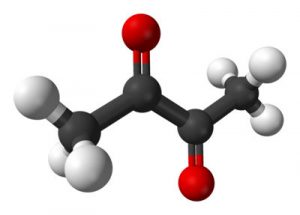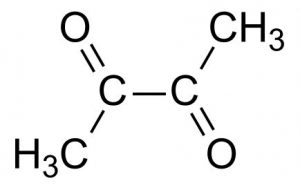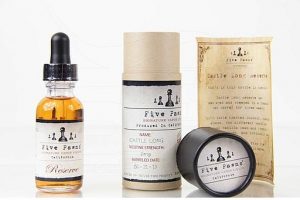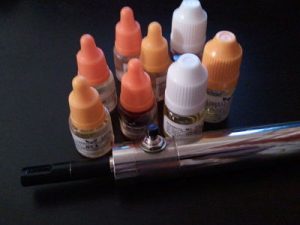Diacetyl in E-Cigarettes, Should You Be Worried?
Throughout the years, e-cigarette opponents have been using a variety of arguments and theories to fuel the ongoing war on vaping, but while most of them have been debunked by solid scientific and social research, there is one question that not even science can answer yet – is the diacetyl used in some e-liquids hazardous to vapers’ health?
 First of all, let’s talk a bit about this controversial organic compound. Diacetyl is a yellow/green liquid with an intensely buttery flavor that occurs naturally in foods such as butter, vinegar and honey and is also produced during the fermentation process of alcoholic beverages and cheese. Its strong buttery flavor makes diacetyl one of the most widely used food flavorings and is regarded as “generally safe” for consumption by the Food and Drug Administration. However, that only refers to the ingestion of this substance, not its inhalation in vapor form. That, as you can read in the following paragraphs, is a whole other matter.
First of all, let’s talk a bit about this controversial organic compound. Diacetyl is a yellow/green liquid with an intensely buttery flavor that occurs naturally in foods such as butter, vinegar and honey and is also produced during the fermentation process of alcoholic beverages and cheese. Its strong buttery flavor makes diacetyl one of the most widely used food flavorings and is regarded as “generally safe” for consumption by the Food and Drug Administration. However, that only refers to the ingestion of this substance, not its inhalation in vapor form. That, as you can read in the following paragraphs, is a whole other matter.
The fears surrounding diacetyl inhalation can be traced back to the late 1990’s, when a number of former workers at a Missouri microwaveable popcorn plant were diagnosed with fixed airways obstruction – obstruction that did not respond to bronchodilators. Half of them were flavoring mixers at the plant, who had gotten the highest exposure to flavorings. An investigation was conducted among the 135 current workers of the popcorn plant and results showed that 25 percent of them had abnormal pulmonary function and that the overall airways obstruction risk was over three times what would have been expected. Among never smokers that risk was 10 times higher than normal. Needless to say, something smelled fishy, or should I say buttery?
The investigation revealed that diacetyl, the substance used to give microwaveable popcorn their delicious buttery taste, was the predominant volatile compound in the Missouri plant. The former workers suffering from severe fixed airways obstruction had been initially diagnosed with a variety of respiratory conditions such as pneumonia, asthma, bronchitis, sinusitis, hay fever, etc., but CT scans ultimately revealed something way more troubling – they were all suffering from a condition known as “bronchiolitis obliterans”.
Bronchiolitis Obliterans, or “popcorn lung disease” as it has come to be known since it s discovery at the popcorn plant, is a life-threatening medical condition that causes the bronchioles (small airway branches in the lungs) to compress and narrow due to the forming of fibrosis (scar tissue). Breathing capacity is severely diminished and sufferers often require lung transplants in order to survive. Ironically, these transplants can be a cure but also a cause of bronchiolitis obliterans.
Since the aforementioned findings at the Missouri microwaveable popcorn plant, workers affected by bronchiolitis obliterans were identified in multiple lines of work, including microwave popcorn, flavoring manufacturing, diacetyl production, and most recently, coffee processing and others inhaling flavoring components. These findings have confirmed the fact that diacetyl, when heated and inhaled over a long period of time, can lead to popcorn lung disease.
So how does all this relate to electronic cigarettes? In 2014, Dr. Konstantinos Farsalinos, of the Onassis Cardiac Surgery Center in Athens, a known supporter of vaping as a less-hazardous alternative to smoking, was conducting some tests on e-liquids from a German supplier when he made a startling discovery. The liquids contained diacetyl in concentrations far higher that those recommended by the National Institute for Occupational Safety and Health (NIOSH). Even more troubling was that the supplier had no idea of its presence in the juice, despite having previously tested for it. Which leads us to a very complicated question – why is their diacetyl in e-liquid, anyway?
In the beginning, manufacturers added it to their e-liquid formulas because of its great buttery taste. It’s what  makes flavors like butterscotch taste so unbelievably delicious and some fruit flavors taste “ripe”. As Oliver Kershaw of Vaping.com notes, “diacetyl is, in a sense, the monosodium glutamate flavor-enhancer of vaping.”
makes flavors like butterscotch taste so unbelievably delicious and some fruit flavors taste “ripe”. As Oliver Kershaw of Vaping.com notes, “diacetyl is, in a sense, the monosodium glutamate flavor-enhancer of vaping.”
But then, around 2010, a growing number of vapers became aware that some of their favorite e-liquids contained diacetyl and that this posed a health risk, so manufacturers started asking their flavoring suppliers to remove diacetyl from the formulas they ordered, and began making claims that their juices were diacetyl-free. You know, like the ones tested by Dr. Farsalinos.
Following his initial discovery, the Greek researcher ordered a series of popular e-liquids anonymously and tested them for diacetyl. 74% of the sweet flavors he analyzed contained the controversial compound, 47.3% of which exposed consumers to levels higher than those approved by NIOSH. Instead of publishing the names of the companies selling these liquids, he wrote them directly, reporting the findings and asking them to make the appropriate changes.
Although many companies claimed they were conducting regular lab tests, it soon became clear that these were not done properly. Because the limits of detection were set higher than those approved by NIOSH, standard gas chromatography–mass spectrometry tests for diacetyl came back negative. Dr. Farsalinos’ research helped change things for the better, but because we currently have no quality control regulations for e-liquid, companies are not actually required to conduct these lab tests, so it’s basically a ‘buyer beware’ issue. Some e-cigarette associations, like ECITA, require members to conduct regular testing and even commissions tests itself, but that certainly doesn’t apply to all e-liquid companies.
Now for the more complicated ‘should you, as a vaper, be worried’ part. Diacetyl in e-cigarettes definitely raises some concerns, but don’t for a moment think that you’re better off going back to smoking tobacco cigarettes. Apart from the tar, carbone monoxide and thousands of known carcinogens, cigarette smoke also contains about 100 times more diacetyl than what Dr. Farsalinos found in the worst offending e-liquids he tested. No, smoking is definitely not a safer alternative, not by a long shot.
Bronchiolitis obliterans hasn’t yet been associated with smoking, which, considering the levels of diacetyl smokers are exposed to, sounds reassuring for us vapers. However, the exact causes of other respiratory conditions related to smoking, like COPD and emphysema, are not yet fully understood and there is a probability that diacetyl may be a culprit. Also, bronchiolitis obliterans is a very rare, underdiagnosed disease. Accurate diagnosis requires invasive biopsies, so cases may sometimes be misdiagnosed as COPD or emphysema.
 While the presence of diacetyl in some e-liquids has been totally blown out of proportion by the media, anti-smoking groups and e-cigarette opponents in general, considering the amount of diacetyl required to cause popcorn lung disease is likely higher than what is contained in e-liquids, you can actually take some precautions:
While the presence of diacetyl in some e-liquids has been totally blown out of proportion by the media, anti-smoking groups and e-cigarette opponents in general, considering the amount of diacetyl required to cause popcorn lung disease is likely higher than what is contained in e-liquids, you can actually take some precautions:
The first thing you can do is buy diacetyl-free e-liquids from known and respectable brands that use lab-tested ingredients. Ever since Dr. Farsalinos’ findings became public, most big brands have taken serious steps towards testing their products appropriately in order to offer their clients e-liquids that are actually diacetyl free.
In case that’s not good enough, just stay away from buttery, creamy and custard-like flavors, or better yet, vape unflavored e-liquid.
If you ask me, there is a silver-lining to this whole diacetyl controversy. Whether fears surrounding its inhalation are founded or not, it’s probably only a matter of time before diacetyl and its not-so-distant cousin acetyl propionyl – which is often used as a substitute – are completely removed from e-liquids, both to keep customers happy and give the ANTZ one less reason to attack e-cigarettes.

















here is an article about everything that is contained in ejuice http://blog.jvapes.com/e-liquid-ingredients-what-is-in-e-liquid/